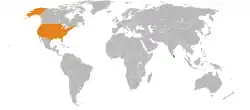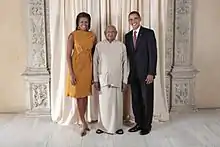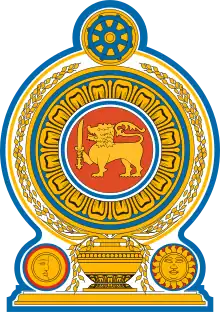Sri Lanka–United States relations
In a 2005 BBC World Service Poll, 30% of Sri Lankans view American influence positively, with 20% expressing a negative view.[1] According to the 2012 U.S. Global Leadership Report, 14% of Sri Lankans approve of U.S. leadership, with 37% disapproving and 49% uncertain.[2]
 | |
Sri Lanka |
United States |
|---|---|
History

American people had been visiting the island since 1788, as spice traders and whalers. American Mission, established in 1813 Jaffna as part of the evangelising effort of the American Bord of Commissioners for Foreign Mission. [3]
U.S. assistance has totalled more than $2 billion since Sri Lanka's independence in 1948.[4] Through the U.S. Agency for International Development (USAID), it has contributed to Sri Lanka's economic growth with projects designed to reduce unemployment, improve housing, develop the Colombo Stock Exchange, modernize the judicial system, and improve competitiveness.[5] In addition, the International Broadcasting Bureau (IBB) operates a radio-transmitting station in Sri Lanka.[4]
At the June 2003 Tokyo Donors' Conference on Sri Lanka, the United States pledged $54 million, including $40.4 million of USAID funding. Following the 2004 tsunami, the United States provided $135 million in relief and reconstruction assistance.[6]
In 2004, Prime Minister Ranil Wickramasinghe was invited to the White House by President George W. Bush.[7]
In early 2005, U.S. Secretary of State Colin Powell visited Sri Lanka in the aftermath of the 2004 Indian Ocean tsunami.[8]

In May 2015, U.S. Secretary of State John Kerry visited Sri Lanka for an official tour. Kerry said that the U.S. would send advisers who would provide "technical assistance" to the newly elected government of Maithripala Sirisena.[8][9]
In December 2015, U.S. Counsellor of the State Department Thomas Shannon visited Sri Lanka. The first U.S.–Sri Lanka partnership dialogue to improve Governance, Development Cooperation and People-to-People ties; Economic Cooperation; Security Cooperation and International and Regional Affairs was announced. The U.S. offered assistance to help Sri Lanka become an economic and strategic hub in the Indian Ocean region.[10]
In February 2020, the U.S. State Department banned Sri Lanka's Army Chief Shavendra Silva from entering the United States for alleged human rights violations during the final phase of the Sri Lankan Civil War. The Sri Lankan government opposed the sanctions, saying: "The Government of Sri Lanka takes strong objection to the imposition of travel restrictions on Lt. Gen. Silva and his immediate family members by the Government of the United States, based on independently unverified information".[11]
On 27 October 2020, U.S. Secretary of State Mike Pompeo visited Sri Lanka as part of a tour through several Asian countries, which also included India, the Maldives, Indonesia and Vietnam. He denounced the Chinese Communist Party as a "predator" and said that the U.S. instead came as a "friend" after meeting with Sri Lankan President Gotabaya Rajapaksa and Foreign Minister Dinesh Gunawardena.[12][13] Gunawardena stated: "Sri Lanka is a neutral, non-aligned country committed to peace, as I mentioned earlier. On that principles, we hope to continue with our relations with the United States and other countries."[13]
Defence relations
.jpg.webp)
The U.S. Armed Forces maintain a limited military-to-military relationship with the Sri Lanka defense establishment.[4] United States and Sri Lanka started to enhance defence relations beyond the sale of military equipment, and training facilities were extended when Sri Lanka was in an internal battle with a secessionist movement Tamil Tigers. During Ranil Wickremesinghe's time as Prime Minister in 2002, agreements were signed with the US which allowed Sri Lanka to get assistance in terms of military training, military technology, intelligence, special training in counter-terrorism, and direct monetary assistance for military development.[14] During the ceasefire period, United States Pacific Command assessment team conducted a study from 12 September 2002 to 24 October 2002, which made several recommendations to strengthen the capabilities of the Sri Lanka Army, Sri Lanka Navy and Sri Lanka Air Force in case of the peace process failing. After studying the weakness of the military, the study recommended the use of cluster bombs (which weren't banned until 2010 when Cluster Munitions Convention came into effect) to destroy unarmoured area targets and arming Kfir's and Mi-24 gunships with guided weapons in case of fighting close to enemy forces.[15][16] The US also donated the SLNS Samudura during this time.[14] Sri Lanka also supported the US by permitting the use of its airspace and airports for flights associated under the Central Intelligence Agency (CIA) extraordinary rendition operations including the transportation of Riduan Isamuddin through Colombo.[17]
It was reported that the US Navy Pacific Command provided intelligence to the Sri Lankan government during the civil war to hunt down LTTE crews and four ships. This was later confirmed by the former president Mahinda Rajapaksa whose government had poor relations with the United States.[18][19][20][21]
Embassies
Principal U.S. embassy officials include:
- Ambassador – Julie Chung[22]
- Deputy Chief of Mission – Andrew C. Mann
- Head of Political Section – Michael DeTar
- Head of Economic/Commercial Section – Robert Gabor
- Management Officer
- Consular Officer – Joel Weigert
- Defense Attaché – Lt. Col. Lawrence A. Smith III
- Director, USAID – Rebecca Cohn
- Public Affairs Officer – Jeff Anderson
- IBB Station Manager – William Martin
The U.S. Embassy in Sri Lanka is located in Colombo, as are the U.S. Agency for International Development offices and Public Affairs offices. IBB offices are located near Chilaw, 75 km north of Colombo.
Sri Lankan Embassy is located in Washington, D.C., and Consulate General of Sri Lanka in Los Angeles
See also
References
- BBC World Service Archived 18 January 2007 at the Wayback Machine
- U.S. Global Leadership Project Report - 2012 Gallup
- SHERMAN, RICHARD MOREY (1990). "American Contacts with Ceylon in the 19Th Century an Introduction to Their Impact". Journal of the Royal Asiatic Society of Sri Lanka. 35: 1–8. ISSN 1391-720X. JSTOR 23731152.
- "U.S. Relations With Sri Lanka". U.S. Department of State. Retrieved 22 July 2015.
- "Humanitarian Assistance". USAID. Retrieved 22 July 2015.
- Gamage, Daya. "US Tsunami aid to Sri Lanka for 2005 tops $135 million". Asian Tribune. Retrieved 22 July 2015.
- "Sri Lankan PM meets Bush amid political crisis". YouTube. Associated Press. 21 July 2015. Archived from the original on 21 December 2021. Retrieved 26 April 2021.
- Colombo, Associated Press in (2 May 2015). "John Kerry praises Sri Lanka on reforms and pledges renewed ties with US". Associated Press. Retrieved 28 January 2022 – via The Guardian.
- Morello, Carol (2 May 2015). "Kerry: U.S. will deepen ties with Sri Lanka". The Washington Post. ISSN 0190-8286. Retrieved 18 January 2022.
- Wroughton, Leslie; Aneez, Shihar (2 May 2015). "Kerry visits Sri Lanka, pledges support for new government". Reuters. Archived from the original on 3 May 2015. Retrieved 26 April 2020.
- "U.S. bans Sri Lankan army chief from entry, citing civil war abuses". Reuters. 14 February 2020. Retrieved 26 April 2021.
- Singh, Namita (29 October 2020). "China is a 'predator', Pompeo tells Sri Lanka". The Independent. Archived from the original on 24 May 2022. Retrieved 26 April 2021.
- Rej, Abhijnan (29 October 2020). "Mike Pompeo Visits Sri Lanka and the Maldives in a Bid to Win Friends and Influence People". The Diplomat. Retrieved 26 April 2021.
- "Silence Breaks : Part Three - Ranil's Presidential Dream Crumbled Down - Natarajah Kuruparan". Archived from the original on 19 August 2016. Retrieved 14 July 2016.
- "Use of cluster ammo not banned during war".
- "US asked SL to use cluster bombs against Tigers".
- "SL supported CIA in torture program-report". www.dailymirror.lk. Retrieved 8 April 2021.
- "U.S. wants 'enhanced' military relations with Sri Lanka | Asian Tribune". asiantribune.com. Retrieved 25 November 2015.
- "India, US gave navy intelligence to fight the LTTE | Colombo Gazette". 4 December 2015. Retrieved 4 December 2015.
- "US helped destroy some LTTE 'floating arsenals'-President".
- "US Navy's Pacific Command behind destruction of LTTE".
- "Ambassador | Embassy of the United States Sri Lanka and the Maldives". Archived from the original on 13 June 2011. Retrieved 13 December 2010.
![]() This article incorporates public domain material from U.S. Bilateral Relations Fact Sheets. United States Department of State.
This article incorporates public domain material from U.S. Bilateral Relations Fact Sheets. United States Department of State.
